

Outliers Worksheet. STatistics Education Web (STEW) One of the goals of the American Statistical Association is to improve statistics education at all levels.

Through the STatistics Education Web (STEW), the ASA is reaching out to K-12 mathematics and science teachers who teach statistics concepts in their classrooms. STEW is an online resource for peer-reviewed lesson plans for K-12 teachers. The web site is maintained by the ASA and accessible to K-12 teachers throughout the world. Statistics and probability concepts are included in K-12 curriculum standards, in particular the Common Core State Standards, and on state and national exams; however, few K-12 teachers have formal training or applied experience with statistical concepts.
K-12 teachers need a place where they can find peer-reviewed teaching materials available in a standard format. STEW lesson plans identify both the statistical concepts being developed and the age range appropriate for its use. Lesson Plans. GCSE MATHS TAKEAWAY. Worksheets - www.m4ths.com GCSE & A Level maths DVD's. Maths-it Podcast - Revision podcasts and worksheets for GCSE and A Level. Mean, Median and Mode. Data Handling, Stem and Leaf Plot, Math worksheet for Grade 6 at myTestBook.com. (2) Reading bar charts: comparing two sets of data.
Stem and Leaf Plots. Free Printable Math Worksheets For Kids. Our Students. Their Moment.
First Steps Mathematics - Steps Resources - The Department of Education. Scootle. Probability - National STEM Centre Search. What's New. Formative Assessment Lessons (beta) Read more about the purpose of the MAP Classroom Challenges… Mathematical goals This unit is designed to help students to: Confront and overcome common probability misconceptions.Count equally likely outcomes using diagrams.Discuss relationships between theoretical probabilities, observed outcomes and sample sizes.Calculate probabilities of independent events.
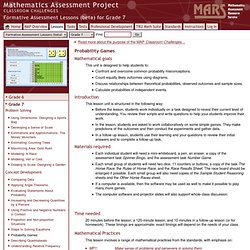
Introduction This lesson unit is structured in the following way: Before the lesson, students work individually on a task designed to reveal their current level of understanding. Materials required Each individual student will need a mini-whiteboard, a pen, an eraser, a copy of the assessment task Spinner Bingo, and the assessment task Number Game.Each small group of students will need two dice, 11 counters or buttons, a copy of the task The Horse Race, the Rules of Horse Race, and the Race Results Sheet.
Time needed. Welcome to the Mathematics Assessment Project. “And I’m calling on our nation’s governors and state education chiefs to develop standards and assessments that don’t simply measure whether students can fill in a bubble on a test, but whether they possess 21st Century skills like problem solving and critical thinking and entrepreneurship and creativity.” President Obama, 1 March 2009. New for 2013: Ten new 'Classroom Challenge' formative assessment lessons for Middle School are now available, including the first five lessons for Grade 6 .
A draft Brief Guide for teachers and administrators (PDF) is now available, and is recommended for anybody using the MAP Classroom Challenges for the first time. Project goals The project is working to design and develop well-engineered assessment tools to support US schools in implementing the Common Core State Standards for Mathematics (CCSSM). Www.greatmathsteachingideas.com/wp-content/uploads/2012/03/Frequency-graphs-and-histograms.pdf. Who-is-the-best-batsman-Mean-Median-and-Mode-investigation.pdf. Www.greatmathsteachingideas.com/wp-content/uploads/2012/02/Scatter-graph-task-height-vs-arm-length-are-they-related-.pdf. What's the probability you live in an odd numbered house? Data Analysis & Probability Games. Featured Game: M & M Probability Game Data Analysis & Probability Games These activities support students as they conceptually develop a sense of how probability affects the outcome of games.
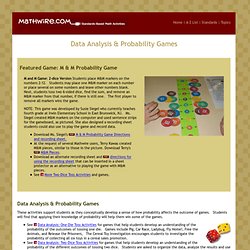
Students will find that applying their knowledge of probability will help them win some of the games. See Data Analysis: One-Die Toss Activities for games that help students develop an understanding of the probability of the outcomes of tossing one die. Socrative probability intro quiz. Primary (F-Year 6): Mathematics: Statistics and Probability teaching resources. Smarties Sheets. Smarties Probability Activity. Probably Graphing. Begin this activity by asking all students to stand up.
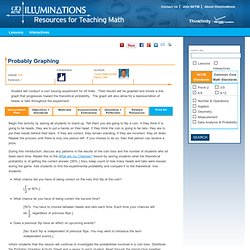
Tell them you are going to flip a coin. If they think it is going to be heads, they are to put a hands on their head. If they think the coin is going to be tails, they are to put their hands behind their back. If they are correct, they remain standing, if they are incorrect, they sit down. Repeat the process until there is only one person left. During this introduction, discuss any patterns in the results of the coin toss and the number of students who sit down each time. What chance did you have of being correct on the very first flip of the coin? Inform students that this lesson will continue to investigate the probabilities involved in a coin toss. As you read through activity sheet and before students begin the experiment, draw the coordinate plane on the board.
Inform students that when they create their own graphs, they should plots the points representing their data, then connect the points with line segments. X/O Problem . What Are My Chances? In this lesson, students will conduct 5 experiments.
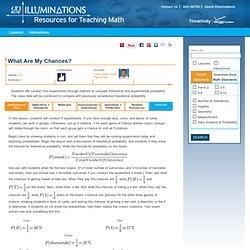
If you have enough dice, coins, and decks of cards, students can work in groups. Otherwise, set up 5 stations, 1 for each game of chance (before class). Groups will rotate through the room, so that each group gets a chance to visit all 5 stations. Begin class by showing students a coin, and tell them that they will be running experiments today and exploring probabilities.
Begin the lesson with a discussion of theoretical probability. Discuss with students what the formula means. Stick or Switch? The Situation Pose the following situation to the students: During a certain game show, contestants are shown three closed doors.
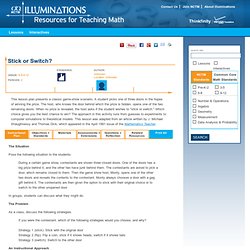
One of the doors has a big prize behind it, and the other two have junk behind them. The contestants are asked to pick a door, which remains closed to them. Then the game show host, Monty, opens one of the other two doors and reveals the contents to the contestant. The Game of SKUNK. Write the following questions on the chalkboard or overhead: I might make more money if I was in business for myself; should I quit my job?

An earthquake might destroy my house; should I buy insurance? My mathematics teacher might collect homework today; should I do it? Ask students to share their responses to each of these scenarios. Ask students why their responses may be different from their classmates. Every day each of us must make choices like those described above. Baby girl, Poppy, breaks 101-year run of baby boys in Silverton family. Happy parents ...

Danielle Andrews and Jeremy Silverton with their daughter Poppy at their farm in Tiverton, Devon in England. Source: Snapper Media A BRITISH family is celebrating more than just the arrival of their baby girl. The birth of Poppy on September 9 also marked the end of a 101-year run of baby boys in the Silverton family. The Silverton family has not had a baby girl since 1913 but the spell was finally broken by Jeremy Silverton, 43, and his partner, Danielle Andrews, 36 from Tiverton in Devon. The last female born into the family was Poppy’s late great aunt Jessie Silverton, who was born 101 years ago, ITV News reported. Jessie’s parents had five children between 1910 and 1917. The History of the Lottery. Dan Gilbert: Why we make bad decisions. Why do competitors open their stores next to one another? - Jac de Haan. Perfect Games - Numberphile. The Probability Song.
Math Worksheets - Graphing page 1. Monty Hall. 11 Plus: Key Stage 2 Maths: Handling Data, Probability, Chance, 11 Plus Practice papers, KS2 Practice papers, Probability is all about how likely it is for something to happen. Probability is the likelihood or chance of an event happening. Probability can. Probability is all about how likely it is for something to happen.
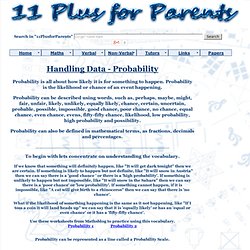
Probability is the likelihood or chance of an event happening. Probability can be described using words, such as, perhaps, maybe, might, fair, unfair, likely, unlikely, equally likely, chance, certain, uncertain, probable, possible, impossible, good chance, poor chance, no chance, equal chance, even chance, evens, fifty-fifty chance, likelihood, low probability, high probability and possibility. Probability can also be defined in mathematical terms, as fractions, decimals and percentages. To begin with lets concentrate on understanding the vocabulary. If we know that something will definitely happen, like "It will get dark tonight" then we are certain. What if the likelihood of something happening is the same as it not happening, like "If I toss a coin it will land heads up" we can say that it is 'equally likely' or has an 'equal or even chance' or it has a 'fifty-fifty chance'.
Probability Worksheet. Probability with Spinners - Free Printable Tests and Worksheets - HelpTeaching.com. What is the probability that the spinner will land on an odd number?
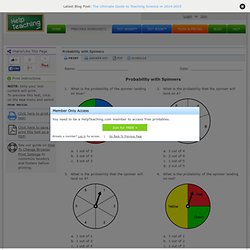
1 out of 6 2 out of 6 3 out of 6 6 out of 6. Probability - Free Printable Tests and Worksheets - HelpTeaching.com. MyMaths.co.uk - Integrate. Probability Theory. Deterministic Experiments With deterministic experiments, the results can be predicted before the experiment is conducted. Example If a stone is dropped from a window, it is know, undoubtedly, that the stone will go down. If it is throw up in the air, it is know that it will travel upwards over a certain time interval; but afterwards will come down. Random Experiment With random experiments, the results cannot be predicted, since they depend on chance. Examples. Introduction to Probability Worksheet: Zero to One. ------ Note: The Information above this point will not be sent to your printer -------- ------ Note: The Information below this point will not be sent to your printer -------- Related Resources The various resources listed below are aligned to the same standard, (7SP05) taken from the CCSM (Common Core Standards For Mathematics) as the Statistics and probability Worksheet shown above.
Understand that the probability of a chance event is a number between 0 and 1 that ... Statistics Worksheets - printable math worksheets for high school Statistics and Probability. Higher or Lower – Math Game Time. Simple Probability Questions - Math Worksheet – Math Game Time. Probability and Statistics activities. Data & probability. Mutually Exclusive Events. In this lesson, we will learn how to find the probability of mutually exclusive events. We will also compare mutually exclusive events and independent events. Related Topics: More lessons on Probability Probability of Mutually Exclusive Events Two events are said to be mutually exclusive if they cannot happen at the same time. For example, if we toss a coin, either heads or tails might turn up, but not heads and tails at the same time.
If A and B are mutually exclusive events then the probability of A happening OR the probability of B happening is P(A) + P(B). P(A or B) = P(A) + P(B) Probability Theme Unit. Probability and Statistics Worksheets. Probability and Statistics Pack - Beginner to Advanced - Easy to Understand View Now... Probability Worksheets. Probability Worksheets. Dynamically Created Math Worksheets. Dynamically Created Math Worksheets. Dynamically Created Math Worksheets. Dynamically Created Math Worksheets. Probability With a Deck of Cards Worksheet. Teaching Probability: Watch A Lesson Plan On Teaching Probability To Students. What Is The Birthday Paradox? 23 and Football Birthdays - Numberphile. How many ways can you arrange a deck of cards? - Yannay Khaikin. Activity: An Experiment with a Die. Interesting point Many people think that one of these cubes is called "a dice".
But no! The plural is dice, but the singular is die. (i.e. 1 die, 2 dice.) The common die has six faces: Probability. Probability explained.